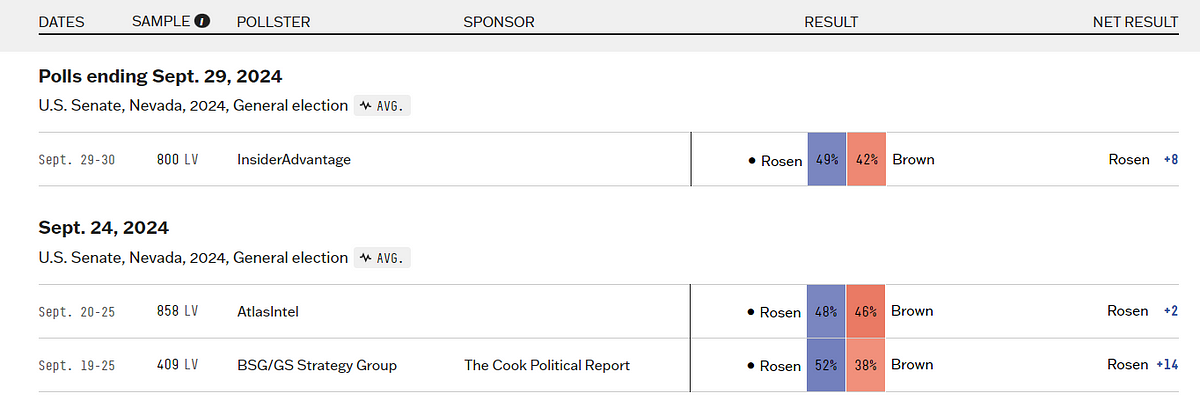Kamala Harris is not coasting to victory; she is working hard and is on the right path to bring this one home. Her efforts at the top have shifted House races, seat by seat, in favor of the Democrats.
Last month, half a dozen seats moved toward the Democrats, and this month, another half a dozen have shifted as well. This, in itself, has brought the Speaker’s gavel within reach for the Democrats. The Senate, however, remains tilted toward the Republicans.
The chaos Trump & Co. have created after taking full control of the RNC, could ultimately result in a tied Senate
Both the Republican and Democratic National Committees raise funds to support Presidential, Senate, and House campaigns. These funds are used for various purposes, including advertising, get-out-the-vote efforts, and voter outreach initiatives. While individual candidates often have their own campaign fundraising operations, the RNC provides additional resources to close funding gaps, particularly in competitive races.
Take political spending data from the Federal Election Commission (FEC) during the 2020 cycle as an example.
There are four distinct layers: Presidential, Congressional (House and Senate), Party Committees (National and other) , and PACs (Outsiders). All of them work together toward a common goal. The National Committees, along with the Republican Senate Campaign and Republican House Campaign arms, play a critical role in identifying gaps and channeling party resources toward the right opportunities.
In 2020, when South Carolina Senator Lindsey Graham was overwhelmed by an alarming influx of cash to his Democratic opponent Jamie Harrison, Mitch McConnell’s Super PAC, the Senate Leadership Fund, injected $20 million into the race with just weeks left on the clock. This financial support helped Graham win the election. Although the final results made the race seem less competitive, it didn’t feel that way during the campaign, and it could have easily gone wrong.
National Committees matter. Senate campaign arms matter.
Identifying the right openings in the electoral map and supporting vulnerable candidates in competitive races can make or break the push for a majority.
I don’t think Mitch McConnell is in control of the 2024 Senate race. Thanks to Donald Trump filling the party with his loyalists, McConnell — a formidable and worthy opponent — is likely sidelined from key decision-making. The way Republicans are spending on Senate races this year reflects Donald Trump’s notorious financial mismanagement.
From the start, Democrats established a solid and stable lead in Ohio and Pennsylvania, two states where Republicans have spent the bulk of their funds. Over $250 million has already been poured into these two races. Meanwhile, $30 million was spent in Maryland, a state where the GOP faces long odds. In Nevada, a state the GOP could potentially win in both the Presidential and Senate races, only $19 million has been allocated.

Of all places, Texas has seen Republicans spend $40 million. Compare that to Florida, where they’ve spent just $10 million. Yes, the race in Texas is competitive, and I’ve argued that Democrats should give it a shot, but that’s from my perspective. From the Republican standpoint, they should be targeting vulnerable Democratic candidates and media markets that play to their advantage.
But that’s not what’s happening.
The GOP has very little chance of ousting incumbent Senator Bob Casey in Pennsylvania. Even Republican pollsters, who tend to boost their numbers, have had Casey in the lead since the Senate race polling began. It makes no sense. The only logical explanation is that the RNC lacks clarity on where to invest strategically.
There can only be one reason: the party has been hijacked by outsiders like Elon Musk, Peter Thiel, other big names, and Trump loyalists. They aren’t even spreading the money evenly — they’re funneling it to candidates they deem important. Some get preferential treatment, while others don’t.
In fact, the GOP is spending 2.3 times as much to help former hedge fund CEO Dave McCormick oust a strong Democratic incumbent in Pennsylvania as in Michigan, a similarly purple state that has an open seat.
More money is going into defending Sen. Ted Cruz’s Texas seat, which is considered in play but not highly at risk, than in three Senate races in presidential battlegrounds.
In Arizona, Rep. Ruben Gallego (D-Ariz.) alone is spending more than all the Republican advertisers, including outside groups, combined.
GOP super PACs and mega-donors are putting more money into former Gov. Larry Hogan’s uphill Senate bid in blue-leaning Maryland than in the Sun Belt targets.
If Democrats had a more favorable map this cycle, they would likely be poised to win the Senate majority. But unfortunately for them, they’re defending multiple states that traditionally vote Republican. I believe the Senate is still the GOP’s to lose, but they seem to be doing their best to lose it.






We cannot let Trump get control; here is his character:
https://barrygander.substack.com/p/preview-lucky-loser-how-donald-trump